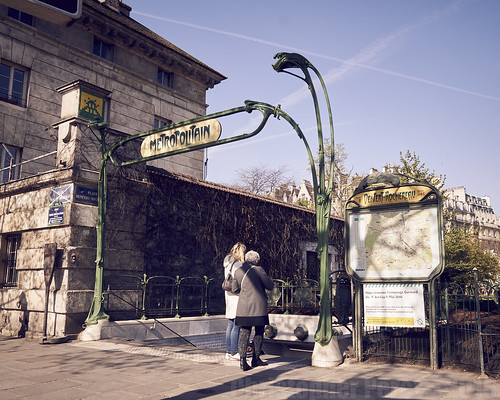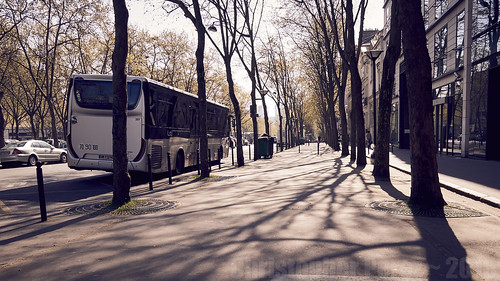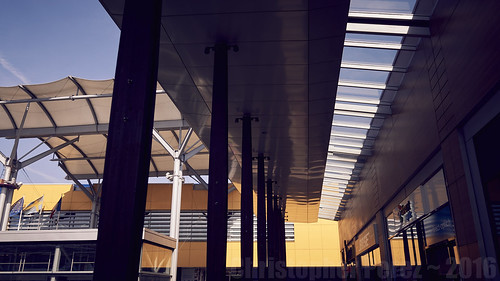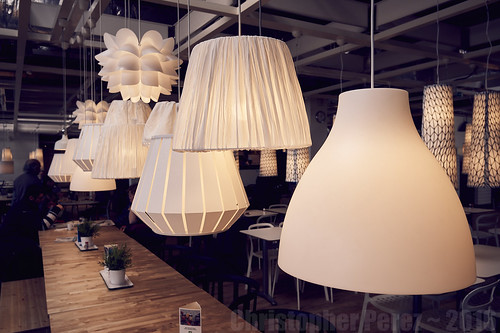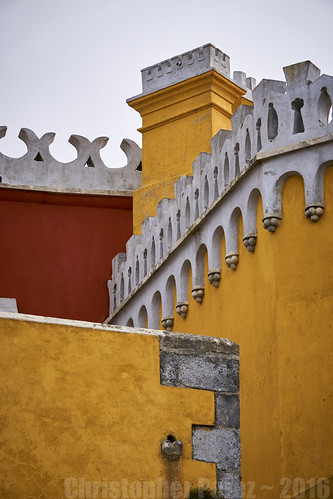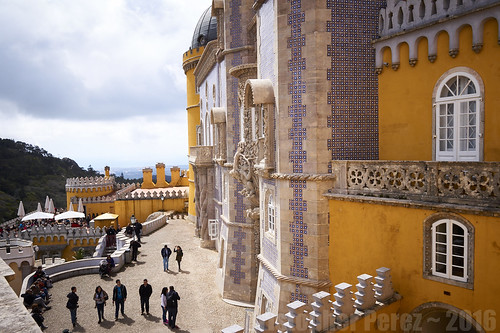In the last post I proposed a driving situation that generated a number of questions that I would like now to attempt to answer.
 |
| Photo 1. |
Regarding Photo 1...
Is the street one way or two way? How do we know, with certainty? - From the angle of the photo and from the way cars block our view, there is no way of knowing. Certainly there are cars parked in the on-coming direction, but as we've learned from living here, people park in all sorts of directions, regardless of the sense of direction of the roads in question.
If we could see signs on the opposite side of the street, they could give us a hint. That is, if signs on the opposite side of the street faced us, then we could safely assume (and assume is indeed the operative word here) that we are on a road direction sens unique. If we see the backs of signs, then it's likely a two direction road. Since I know this road, I can say that's what it is, two directions.
If we could see signs on the opposite side of the street, they could give us a hint. That is, if signs on the opposite side of the street faced us, then we could safely assume (and assume is indeed the operative word here) that we are on a road direction sens unique. If we see the backs of signs, then it's likely a two direction road. Since I know this road, I can say that's what it is, two directions.
When do we know the 30km/hour speed limit has ended and we can return to blasting up the road? - Unless otherwise noted, the speed restriction ends at the next intersection. Now this is tricky. I learned the "next intersection" to mean at a four way intersection. But there may be other nuanced definitions of "intersection" which apply.
It can be noted that the 30km/hr restriction is ended by a sign placed ahead of the next intersection that shows the 30km/hr speed limit in black and white (most of the time) where an angled bar crosses the number.
It can be noted that the 30km/hr restriction is ended by a sign placed ahead of the next intersection that shows the 30km/hr speed limit in black and white (most of the time) where an angled bar crosses the number.
At what speed do we get to blast up the road at after the speed restriction ends? How do we know this? - The French system of understanding speed restrictions is very different than in the US where speed limits are clearly posted. In France speed restrictions must be memorized. There are minimally three levels of speed depending on if you are a driver in or outside a probationary period (new drivers typically, but not always, are classified in this way for three years), the type of road you are on, and the condition of the weather.
So here you go [and memorise]. Unless otherwise posted -
Urban areas - normal drivers, probatoire drivers, even in rain: 50km/hr - this is allowed on the narrowest and most heavily congested streets.
Undivided roads outside urban areas - normal drivers: 90km/hr, probatoire drivers: 80km/hr, rain: 80km/hr
Divided roads (roads with center medians or barriers) outside urban areas (many times, but not always, classified as routes) - normal drivers: 110km/hr, probatoire drivers: 100km/hr, rain: 100km/hr
Autoroute outside urban areas - normal drivers: 130km/hr, probatoire drivers: 110km/hr, rain: 110km/hr
Autoroute through urban areas - normal drivers: 110km/hr, probatoire drivers: 100km/hr, rain: 100km/hr
Exceptions to this (this being France, there are often exceptions) - le peripherique around Paris - normal drivers: 90km/hr, probatoire drivers: 80km/hr, rain: 80km/hr - though this changes. I've seen le peripherique speeds limited to 70km/hr. There are two other areas in France where Autoroute in urban areas are less than "normal" and you need to know where they are before driving in those areas.
Things get tricky in foggy conditions. The rule is this - For as many metres as you can see, that translated into km/hr is your speed. For instance, if you can see 50 metres, then your speed would be 50km/hr. This applies on routes and autoroutes.
So here you go [and memorise]. Unless otherwise posted -
Urban areas - normal drivers, probatoire drivers, even in rain: 50km/hr - this is allowed on the narrowest and most heavily congested streets.
Undivided roads outside urban areas - normal drivers: 90km/hr, probatoire drivers: 80km/hr, rain: 80km/hr
Divided roads (roads with center medians or barriers) outside urban areas (many times, but not always, classified as routes) - normal drivers: 110km/hr, probatoire drivers: 100km/hr, rain: 100km/hr
Autoroute outside urban areas - normal drivers: 130km/hr, probatoire drivers: 110km/hr, rain: 110km/hr
Autoroute through urban areas - normal drivers: 110km/hr, probatoire drivers: 100km/hr, rain: 100km/hr
Exceptions to this (this being France, there are often exceptions) - le peripherique around Paris - normal drivers: 90km/hr, probatoire drivers: 80km/hr, rain: 80km/hr - though this changes. I've seen le peripherique speeds limited to 70km/hr. There are two other areas in France where Autoroute in urban areas are less than "normal" and you need to know where they are before driving in those areas.
Things get tricky in foggy conditions. The rule is this - For as many metres as you can see, that translated into km/hr is your speed. For instance, if you can see 50 metres, then your speed would be 50km/hr. This applies on routes and autoroutes.
How do we know if a sign is permanent or temporary? - Temporary signs are identical to all other signs in shape and content, with the exception that temporary signs have yellow backgrounds.
With the construction zone signs in this situation, are they permanent or temporary? - In Photo 1 above we can see the construction zone signs have yellow backgrounds, therefore they are temporary.
However, the speed restriction of 30km/hr has a normal background. So, is it temporary or permanent? Here's how you go about trying to sort it all out. Since the speed restriction is on the same pole as the temporary sign and placed above the speed limit you can assume (perhaps wrongly, but we'll have to wait to see) that it too is temporary. If the speed restriction was posted on a separate pole or above the construction sign, then the speed limit could indeed be permanent.
With the construction zone signs in this situation, are they permanent or temporary? - In Photo 1 above we can see the construction zone signs have yellow backgrounds, therefore they are temporary.
However, the speed restriction of 30km/hr has a normal background. So, is it temporary or permanent? Here's how you go about trying to sort it all out. Since the speed restriction is on the same pole as the temporary sign and placed above the speed limit you can assume (perhaps wrongly, but we'll have to wait to see) that it too is temporary. If the speed restriction was posted on a separate pole or above the construction sign, then the speed limit could indeed be permanent.
As a driver of a automobile, can you normally drive in the right hand lane in Photo 1? If so, why? - This is rather tricky. In Photo 1 above we see an arrow directing traffic around the barrier. The dashed line that delineates a lane looks "normal", but it's not. It's hard to see but... the width of dashed line is thicker than "normal". This indicates une voie reservee - a lane reserved, in this case, for buses and bicycles (though it's not obvious since the lane interior is well worn and markings are largely missing). To answer the question - non, "normal" automobiles cannot drive in this lane. Neither can any motorized form of two wheeled transportation. Though everyone does emprunter (borrow - or in this case to drive in) the reserved lane, technically it's not allowed and you can receive une amende.
Regarding Photo 2...
Regardless of how the cars are parked alongside the narrow side-street, how do we know this really is direction sens-unique? - As noted in the discussion of Photo 1 above, the way the signs are facing is the clue as to whether you're on a one way street or not. In this case, signs on the left side of the street are facing your direction. Therefore this is a one way/sens unique road.
What is the speed limit? How do we know this? - As previously outlined for memorization (you did memorize this, right?), since we are in an urban area and unless otherwise posted this would be a 50km/hr street. Narrow? Yes. Lots of pedestrian traffic? Potentially. Children kicking a soccer ball? You betcha. 50km/hr it is.
Unless... and this is also a little tricky... a few streets earlier you came across a square sign with a smaller/small-ish red circle with 30 or 20 displayed on the inside of the circle. This would mean you are entering a "zone" of 30km/hr or 20km/hr. Which is to say, all streets you drive on until you come to a sign that explicitly cancels the speed restriction shall be under-taken at the limit indicated on the square sign. This is not to be confused with the circular speed limit sign we saw in Photo 1 where the restriction pertains to just the road the sign is found on.
Regarding the two streets (photos 1 and 2) considered together...
Unless... and this is also a little tricky... a few streets earlier you came across a square sign with a smaller/small-ish red circle with 30 or 20 displayed on the inside of the circle. This would mean you are entering a "zone" of 30km/hr or 20km/hr. Which is to say, all streets you drive on until you come to a sign that explicitly cancels the speed restriction shall be under-taken at the limit indicated on the square sign. This is not to be confused with the circular speed limit sign we saw in Photo 1 where the restriction pertains to just the road the sign is found on.
Regarding the two streets (photos 1 and 2) considered together...
If you are traveling on the major crosstown street in Photo 1, when you encounter an intersection, who has priority? From which direction is priority given? How do we know this? - I'm quite sure this situation is exactly the kind that get so many French into trouble. So here it goes ->
If a street is entering from the right and there are no other indications of any kind, the driver entering from the right has priority. This is the dreaded priorite a droite. That is to say, if you happen to be on a three lane wide major cross town road and a small one-way street happens to T-bone into your major cross-town road, you, who may be trying to make time to get across the aforementioned town, have to yield to any and all vehicles coming out from the right. This applies whether you can see them clearly or not (see Photo 1).
If a street is entering from the right and you see a triangular sign with an "X" in the middle, it's a warning that at the next intersection you must yield to the right. In principle this is a Good Thing(tm) as it takes away any doubt as to who should do what and when. In practice things can, how shall we say, become "interesting" should someone be sitting on your tailpipe trying to get across town on the aforementioned etc etc etc.
Drivers coming from the right may or may not encounter any signage (see Photo 2) that alerts them to a droite (legal right) about to be gifted them. Normally there is no indication of your State Granted droite. So you can imagine the glee with which some motorists dash pall mall into the midst of cross-town traffic moving at 30km/hr or 50km/hr. On a blind intersection. With a construction zone to further hide your presence. Whereby a barrier hides all but your roofline. But with the added "benefit" of a silver painted fence perched on top of the aforementioned barrier which acts as yet more camouflage, thereby protecting you from, well, speeding on-comers view. This tends to set a trap for the unpracticed and unwary driver.
If a street is entering from the right and there are no other indications of any kind, the driver entering from the right has priority. This is the dreaded priorite a droite. That is to say, if you happen to be on a three lane wide major cross town road and a small one-way street happens to T-bone into your major cross-town road, you, who may be trying to make time to get across the aforementioned town, have to yield to any and all vehicles coming out from the right. This applies whether you can see them clearly or not (see Photo 1).
If a street is entering from the right and you see a triangular sign with an "X" in the middle, it's a warning that at the next intersection you must yield to the right. In principle this is a Good Thing(tm) as it takes away any doubt as to who should do what and when. In practice things can, how shall we say, become "interesting" should someone be sitting on your tailpipe trying to get across town on the aforementioned etc etc etc.
Drivers coming from the right may or may not encounter any signage (see Photo 2) that alerts them to a droite (legal right) about to be gifted them. Normally there is no indication of your State Granted droite. So you can imagine the glee with which some motorists dash pall mall into the midst of cross-town traffic moving at 30km/hr or 50km/hr. On a blind intersection. With a construction zone to further hide your presence. Whereby a barrier hides all but your roofline. But with the added "benefit" of a silver painted fence perched on top of the aforementioned barrier which acts as yet more camouflage, thereby protecting you from, well, speeding on-comers view. This tends to set a trap for the unpracticed and unwary driver.
Do you keep your present speed? If not, what do you do? - If you are the driver with la droite a priorite a droite you can plunge hood-long into the fray protected with the knowledge that anyone who might touch you will be held as the responsible party. It's like a huge Get Out of Jail Free card somewhat randomly granted, and visited upon the French citizenry.
If you are the driver whose view may be blocked to the street situated on the right and who may not be warned of a trap, er, opportunity to practice Serious Accident Avoidance Technique, you learn to, and this is very very important, 1) check your rearview mirrors to check the make and model of la voiture sitting on your tail-pipe (so you can fill out the accident report accurately), 2) retrograde slightly, 3) cover your brakes as you pass into the aforementioned (ah, I do repeat myself, don't I?) intersection, which means that 4) any advantage of using a major crosstown street to reach your destination in a Timely Manner will be dashed at Each and Every intersection you stumble upon.
*breathe*deep breaths*
Thus ends this segment of what I learned about driving in France. There are many many more pages of reading to do before a novice driver can cover perhaps 70 percent of the topic of driving in France. The other 30 percent of what I needed to know and understand was presented only when I sat down to take the Bloody Gawed Foresaken code de la route Test.
And now a musical interlude before we pass on, ahem, to talking about the driving portion of the test.
If you are the driver whose view may be blocked to the street situated on the right and who may not be warned of a trap, er, opportunity to practice Serious Accident Avoidance Technique, you learn to, and this is very very important, 1) check your rearview mirrors to check the make and model of la voiture sitting on your tail-pipe (so you can fill out the accident report accurately), 2) retrograde slightly, 3) cover your brakes as you pass into the aforementioned (ah, I do repeat myself, don't I?) intersection, which means that 4) any advantage of using a major crosstown street to reach your destination in a Timely Manner will be dashed at Each and Every intersection you stumble upon.
*breathe*deep breaths*
Thus ends this segment of what I learned about driving in France. There are many many more pages of reading to do before a novice driver can cover perhaps 70 percent of the topic of driving in France. The other 30 percent of what I needed to know and understand was presented only when I sat down to take the Bloody Gawed Foresaken code de la route Test.
And now a musical interlude before we pass on, ahem, to talking about the driving portion of the test.

